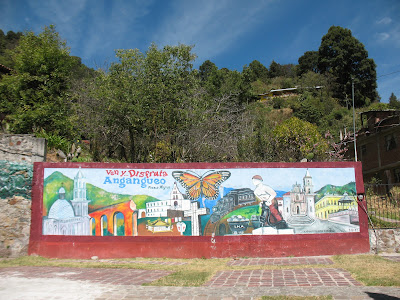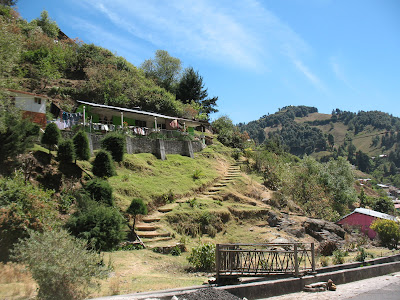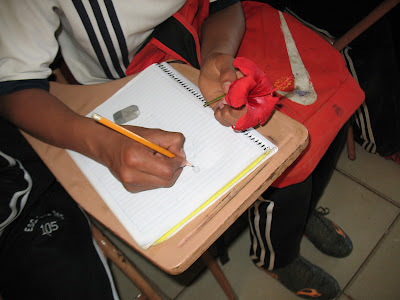MSSP’s Mexico Monarch Country Tour
2020
What a strange world in which we
live, where people are killed for protecting the forest, the forest that
produces the oxygen we need to breathe, the forest that removes carbon dioxide
from the atmosphere, the forest that can save us from some of the worst effects of anthropogenic Climate Change,
the forest that helps to regulate available water, the forest that provides a
winter home for the longest living butterfly and the insect with the longest
migration, the amazing monarch butterfly.
That is what I was thinking about on the plane on my way to Mexico City
to meet up with the other participants of the annual Monarch Sister Schools’
Mexico Tour. We were heading to the
monarch sanctuary in spite of the recent murders of two men, including Homero
Gomez, who had devoted their lives to protecting the forest on which the monarch
butterflies and many other species depend.
Rather than deterring us from the trip, these events reminded us of how
important the trip is. When we rent
hotel rooms near the monarch sanctuary, eat at local restaurants, buy
souvenirs, pay admission, and tip the guides, we are providing a livelihood for
people who protect the butterflies.
From my airplane window I saw how
humans have cut the Earth’s surface into unnatural geometric shapes, altering
groundwater flow and biodiversity. The
depths of the forest become edges of the forest. The forest becomes a monoculture of genetically
modified corn and soy in the U.S. Midwest, and avocadoes in Central Mexico. These are threats faced by monarch
butterflies at each end of their 2,000 mile migration from as far north as
Canada to the unique area 10,000 feet up in the Eastern
Sierra Madre mountain range of Central México where heat-radiating oyamel fir trees provide winter
shelter for the butterflies amid a multitude of endemic, nectar-providing, winter-blooming
wildflowers. There exist only about 10%
as many monarch butterflies as a mere 30 years ago.
La Ciudad
de Mexico
In Mexico City, we stayed at the
Hotel Casa Blanca, with its huge breakfast buffet and a short walk from a park
where locals danced at night to music provided by disc jockeys. It was refreshing to see young people dancing
with partners out in public. Unfortunately,
not seen as often in the U.S., alcohol-free dancing is a good way for people to
get to know each other and have fun, while learning social skills.
Teotihuacán
From Mexico City, we went to
Teotihuacán, the most visited archeological site in Mexico and the location of the largest pre-Columbian city in
the Americas with a population of about 125,000, founded around the 1st
C CE as a religious center and lasting until around the middle of the 7th century. Our very knowledgeable tour guide, Alexander
Ramirez Cruz, led us through multi-family residential compounds with a complex
system of indoor plumbing and elaborate murals.
Teotihuacan exported fine obsidian
tools throughout Mesoamerica, including Veracruz and the Maya region. Obsidian was also carved and polished into a
thin disc through which the sun could be viewed, possibly to observe solar eclipses. Major monuments and houses in Teotihuacan had
been burned around 550 CE, possibly related to strife between the diverse
ethnic groups living there. Around the
same time, a volcano erupted in el Salvador, which may have had far-reaching
effects. Crops were not enough to feed
the growing population, as evidenced by remains of malnourished children,
perhaps related to a climate change event causing widespread drought.
We walked the Avenue of the Dead and climbed the Pyramid of
the Sun and the Pyramid of the Moon. The Pyramid of the Moon was used for public rituals in
which animals and people were sacrificed, and the plaza was used for
astronomical observation and calendar-related activities. The pyramids are built of stone, which is
visible now, but the stone had originally been covered with lime plaster on
which may have been painted brilliantly colored murals, similar to those that
have been uncovered in the ancient priests’ quarters.
Alex pointing out which parts of
the wall are original and which are replicas/

Colorful
murals on the walls
The Pyramid
of the Sun was built on a carefully selected spot, from where it was possible
to align it to the Cerro Gordo mountain to the north and, in the east and west,
to sunrise and sunset on specific dates. The pyramid was built over a man-made tunnel
leading six meters down to a "cave" which might have served as a
royal tomb.
me on the Pyramid of the Moon
National Museum of Anthropology
Next stop was the famous National Museum of Anthropology,
housing the huge Aztec Sun
Stone (Calendar
Stone), giant stone Olmec heads, hoops from a Mayan ball game played to the death in Chichen
Itzá, a model of the former
Aztec capital Tenochtitlán, now Mexico City, and more than anyone could possibly see in one day. My favorite exhibits were the miniature
dioramas of indigenous peoples going about their daily life – hunting, cooking,
caring for children.
Maguey
At a gift
shop, we participated in a demonstration of the traditional uses of maguey, a species
of agave. When a maguey is about 7 years
old, the sap in the base of the stem is harvested for mescal, tequila, pulque,
and/or agave nectar. Agave nectar is a
low-glycemic nectar available in natural foods stores. Pulque, which, by the way, tastes like vomit,
is full of minerals and has traditionally been used medicinally as well as in
religious rituals. Tequila is a type of
mescal that is made from the blue agave and grown in one of 5 states in Mexico,
while mescal can be made from any of 30 types of agave and grown in any of 9
locations. In addition, tequila is typically produced by steaming the agave heart in an industrial
oven and then distilling the liquid in a copper pot, and mezcal is traditionally
cooked in lava rock-lined earthen pits filled with wood and charcoal before
being distilled in clay pots, giving it a smoky flavor.
Pulque is fermented instead of
distilled. Agave has other traditional
uses as well. For example, the leaves
provide string for sewing, and the sharp tip of the leaf can be used as a
needle. Maguey fibers are made into
tablecloths (mantas) or shawls. Layers
of maguey leaves can be peeled off and written on as paper or used for wrapping
food.
Liquid in the center of a maguey/
Demonstration of the use of maguey leaf skin as a writing surface
Mariposa Monarca (Monarch Butterfly)
Just
as the maguey has been a part of Mexican culture for centuries, so has the
monarch butterfly. The Purépecha Indians
believe that each monarch butterfly carries
the soul of one of an people’s ancestors back home to visit on November 1st
and 2nd, corresponding to the celebration of the Day of the Dead,
when villagers camp out in the graveyards to commune with the souls of their
ancestors. These monarchs are on their
way to the oyamel fir forests in the Central Highlands of Mexico. The forests are a fragile ecosystem and
provide the water for Guadelajara, Lake Chapala, and, last but not least, Mexico
City, once the capitol of the Aztec empire and currently the second-largest
metropolitan area in the Western hemisphere.
On
our way to the el Rosario monarch sanctuary, we passed poinsettia growers,
berry farms, and avocado orchards. 80%
of the deforestation in Mexico in order to plant avocadoes is illegal. People have gone into the center of the
oyamel forest in the monarch sanctuary to chop down trees and plant
avocadoes. Avocadoes require copious
amounts of water. Unless the trees are organically
grown, pesticides and fungicides are also used.
How are avocadoes more important than the biodiversity
hotspot of endangered pine-oak forests and oyamel forests? Why can’t we all practice permaculture,
planting and harvesting sustainably, in tune with the natural environment?
Alternare’s Center for Sustainable
Agriculture
Our tour group made a visit to Alternare, a free 9-month
program for local youth wishing to gain skills in permaculture and sustainable
agriculture. Students raise poultry, plant trees to harvest
later for fuel, and grow a variety of crops.
One row in the greenhouse contained prickly pear cactus! Some of us had an opportunity to use the
composting toilets. The purpose of the program is to provide the skills
necessary for each participant to return to his or her community and share the
sustainable farming methods he or she learned at el Alternare. As local communities begin gradually to adopt
these methods, improvements will be seen
in the health of the people and of the natural environment around the monarch
sanctuaries.
 Poultry being let out to
forage/ Garden at Alternare
Poultry being let out to
forage/ Garden at Alternare
Monarch Butterfly Biosphere Reserve
The Monarch
Butterfly Biosphere Reserve is located 62 miles northwest of Mexico City in the
trans-Mexican volcanic belt on the border of the states of Michoacan and
Mexico. The one we visited was el
Rosario in Michoacan. Many local communities
are very poor, with high illiteracy rates and childhood malnutrition. Most families live on subsistence agriculture.
These communities also have a tradition of exploiting the forest to obtain wood
for furniture and other crafts. The
Monarch Sister Schools Program, by leading this annual tour, supports these
local communities by providing income for tour leaders, local restaurants, and artisans. If they can earn money through ecotourism,
they won’t have to exploit the forest.
In
addition to sheltering nearly all of the monarchs from North America’s east
coast and the midwestern U.S. for 4 or 5 months of each year, this endangered
pine-oak forest is home to many species of hummingbirds and endemic plants. Endemic wildflowers living 11,500 feet up in
these forests include...purple salvia - Mexican sage, red Lobelia cardinal
flowers, yellow..., white..., Tagetes erecta (Aztec marigold) . Most of the wildflowers have two blooming
periods per year, one during summer’s rainy season and one in late winter/early
Spring after the short rainy period in February and just in time for the
monarchs to fuel up for their long trip north.
The trip north isn’t as long as the trip south was in October, because
this time the monarchs will stop to breed in Texas. This generation stops there and passes the
baton to their offspring who will continue north. It will be the fourth generation that finally
makes it back to where the wintering butterflies began their southern journey,
sometimes as far north as Canada.
El Rosario Monarch Sanctuary
The highlight of our tour was the visit to the monarch
sanctuary. We followed the signs and stayed with our guide, a member of the
indigenous community which owns part of the sanctuary. Some rented horses to get up the steep hill
to the meadow. Horse rentals provide
seasonal income for young men from neighboring communities, but they also cause
a lot of erosion. Millions of butterflies cluster on the heat-radiating
oyamel trees for warmth. On warm, sunny
days, they drift down to the meadow and the understory to feed from endemic
wildflowers and drink from puddles. This
year, scientists were concerned about the monarchs being too active too early,
breeding in the forests and flying around so much that their wings were
beginning to fade and tatter before they had begun the trip north. I can’t even describe the experience of seeing
and hearing the monarchs flying all around us, practicing flight moves or maybe
just enjoying the serenity themselves! I
brought my art supplies and sat down in the forest, sketching and painting
endemic wildflowers. Next trip, I will
be teaching botanical art workshops for participants.
Angongueo
We visited the old mining town of Angongueo, near el Rosário. There we toured a
couple of old Catholic churches and enjoyed delicious guacamole with
lunch. A couple of young boys tried to
stow away in our tour bus. This is a
very poor town, in spite of being so close to the monarch sanctuary. The old silver mines shut down in the 1980s
but have now opened back up to provide income for the community. Angangueo
recently restored an old train station at the beginning of a four-kilometer
bicycle trail, the Monarch Greenway, connecting two train stations.
Trip participant chatting with local children in the plaza in Angongueo
Monarch Festival in Valle Verde
The day after the official tour had
ended, the annual Monarch Festival began in Valle Verde, including dance
lessons, a parade involving local schoolchildren, and a dance performance of
dance troupes from all over Mexico. Staying
a couple days longer than the others, I had the opportunity to facilitate some Botanical
Art classes to schoolchildren at the Forest Middle School as part of the
Monarch Festival, while emphasizing to the children how unique their forest is,
with its endemic wildflowers and the monarch wintering grounds. These
activities are available for anyone who joins us on the next trip! I was fed sumptuous meals, dressed in a
traditional costume, and invited to march in the Monarch Festival Parade, leading
a group of schoolchildren. The last
evening, William and I attended the dance troupe showcase, watching young
people in fancy outfits twirl their skirts and tip their cowboy hats as they
danced as couples. It made me want to
learn some traditional Mexican dance!
Dancers at the Monarch Festival dance program after the parade in Valle Verde
Sister Schools in Mexico
While our sister schools here in
Maryland and the DC area are growing milkweed and flowers for the monarchs, the
schools in Mexico are growing trees to plant in the forest near the monarch sanctuary. They are also learning about monarch
butterflies’ life cycle and migration and are working to protect their unique
forest habitat.
Mexican teacher raising monarchs in the classroom
How You Can Help the Monarch Butterflies
If you join the Monarch Sister Schools Program on our next
trip to Mexico, you will be providing employment opportunities for people in the
many local communities that are trying to protect the endemic, endangered
pine-oak-oyamel forests. It is an
amazing, life-changing experience, not just the immersion into a forest full of
butterflies, but also the connection with people and the opportunity to make a
real difference in their lives. If you
are a teacher, like Tracey, you can bring home such memories to share with your
students, and you can connect them with children their age who share the common
thread of the monarch butterfly migration.
There will be opportunities to teach science and art workshops to
students and to participate in the Monarch Festival Parade.
Your school can join the Monarch Sister Schools Program,
knowing you are directly helping the monarch butterflies and their habitat by supporting
Internet access for local students, education about the monarchs, and an
international connection. Your school
will be assisted with planting pollinator gardens and teaching environmental
education. You can opt for your students
to participate in cultural connections through Skype sessions with children in
Mexico. We will have a free Teacher
Workshop in September in which we will share some lessons from the Monarchs and
More Curriculum(We have them for sale.) and demonstrate how to make a monarch
cage from household materials (We have kits for sale.).






















































What a wonderful idea..This newsletter should be 1/10 this length ...and posted as a sequel..weekly..4 times a year. Total 40 weeks..!!
ReplyDeleteThank you for reading it. That is excellent advice!
DeleteIn fact, we are planning to do some shorter newsletters from now on,as email blasts to interested parties. If you give me your email, I will send you the first. which announces our upcoming teacher workshop.